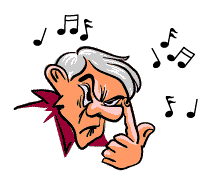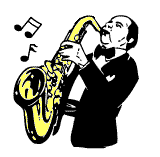(Down - Top)
SAX Intro 1. The easiest instrument to play well
It is often said that
the saxophone is the easiest instrument to play badlyThis is undoubtedly true.
Oddly enough it is equally true to say that
the saxophone is the easiest instrument to play well.
A famous Scandinavian wind instrument player was once asked in an interview how long it takes to learn to play the instrument.
His answer was : "two life times".
 How can these three apparently contradictory statements make sense together ?
How can these three apparently contradictory statements make sense together ?
The answer is simple.
The crucial difference between playing badly and playing well is "know how".
Once you have a clear concept of how to play the saxophone, you simply will not stop getting better. For that is the beauty of music, you never stop learning, not even after two life times.
But you need to have a clear concept of what it is all about. Without it you can play all your life and progress very little.
Perhaps you learn to play a bit faster. So what. It does not mean very much, for :

"It ain't worth a bone, if it hasn't got a tone !"
I regularly get mature students that come to me after a lifetime of playing, who are dissatisfied and frustrated with their playing.
Their problem in each case is the same. They lack a clear concept of how to play the saxophone and therefore don't know what to do to improve.
This is what the Jazclass Saxophone Course is all about.
(Down - Up - Top)
SAX Intro 2. Getting from A to B
We all know that the shortest route between two points, A and B, is a straight line.

To actually travel that route you need four things.
- The location of A
- The location of B
- Transport to travel (your legs, a car, a camel)
- Fuel for the vehicle to get you there (food, petrol, water)
"A" represents the concept of how to play the saxophone.
This is what the Saxophone Course will teach you. It will explain to you in detail what good saxophone playing involves : posture, embouchure, breathing, voicing, articulation, fingering, etc..
The Course also provides the mode of transport in the form of exercises (on tones, overtones, articulation, vibrato and ballads) to get to B.
"B" is your concept of how you wish to sound.
In the first instance this means identifying and listening to your favourite sax player.
As you progress through the Course you will get a better idea of what you should be listening for. This will bring your B more in focus.
Finally the fuel must be provided by yourself. It is the energy required to practise and the motivation to continue no matter what.
Knowing where A and B are and having the means to travel is no good to you if there is no fuel.
 |
Let me tell you about my own journey.
I started playing in my mid 40s. It was quite obvious to me that I was not going to become another Oscar Peterson on the piano or Gerry Mulligan on the baritone sax. This did not matter to me at all.
What I did find absolutely necessary was to know where A and B are, and for me to travel in a straight line to my objective (B). In other words, I did not need to be as good as Peterson or Mulligan, but I wanted to travel on the same road and in the same direction as they did. This to me was and is all important. |
As you travel on the road B will become more and more in focus. However you will never actually get there, for B, like a fata morgana (mirage), will always move further ahead of you.
(Down - Up - Top)
SAX Intro 3. You need a Compass
Like on any journey, it is a good idea to have a compass or guide to ensure that you keep on the right track. You need an objective listener who can assess your progress and make constructive criticism on your efforts.
I recommend you consider three options.
 |
- tape your practice from time to time and listen to it.
You need not do it too often (it can be depressing), but it shows up your inadequacies quite clearly.
- For a small charge (US$ 10.-) I will assess your progress personally.
Send me a tape of your normal practice (I will specify what) and I will comment on it. This is not an exam but a good way to check if you do your exercises correctly. - Find a good private teacher.
Towards the end of the Course it may be a good idea to get some private lessons from a good teacher who can assess you over a period of time. Good teachers are very hard to find, so you may have a few misses before you hit a good one.
Going through this Course will give you the confidence to assess which teacher makes sense and which one does not. |
(Down - Up - Top)
SAX Intro 4. Music as a form of Meditation
Good musical performance is an active form of meditation.

Meditation is a state in which the three aspects of a human being :
Mind - Body - Spiritare
relaxed, in focus and in perfect balance.
Good instrumental practice works towards this state of meditation through :
- natural integration of the instrument as part of the body, and
- the relaxation, focus and balance of body, mind and spirit.